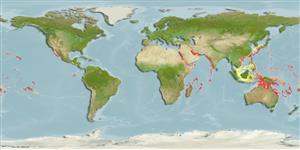Teleostei (teleosts) >
Anguilliformes (Eels and morays) >
Ophichthidae (Snake eels) > Myrophinae
Etymology: Scolecenchelys: Greek, skolex = worm (1855) + Greek, enchlys, -yos = eel (Ref. 45335).
Eponymy: Tom Iredale (1880–1972) was an English artist and naturalist who spent much of his life in Australia. [...] (Ref. 128868), visit book page.
Environment: milieu / climate zone / depth range / distribution range
Ecology
Marine; reef-associated; depth range 0 - 60 m (Ref. 104540). Tropical
Indo-Pacific: widespread, from South Africa to Fiji, north to central Honshu Island, Japan, including Australia and the Red Sea.
Size / Weight / Age
Maturity: Lm ? range ? - ? cm
Max length : 20.0 cm TL male/unsexed; (Ref. 104540)
Short description
Identification keys | Morphology | Morphometrics
Vertebrae: 122 - 129. This species of the Scolecenchelys gymnota species group is distinguished by the following set of characters: head 8.4-10 % TL; tail 51-54 % TL; trunk 34-38 % TL; infraorbital pores 2 at the postorbital area; absence of median ventral groove on the snout; acute snout; rictus of mouth is slightly posterior to a vertical through the posterior margin of the eye; uniserial teeth on jaws and vomer; horizontal distance between dorsal-fin origin and a vertical through mid-anus 3.4-57 % HL; predorsal vertebrae 54-59, preanal 53-56, total vertebrae 122-129; MVF 57-55-126 (Ref. 104540).
A shallow water species occurring from rock tide pools or coral reefs to 60 m depth (Ref. 104540).
Life cycle and mating behavior
Maturity | Reproduction | Spawning | Eggs | Fecundity | Larvae
Hibino, Y. and S. Kimura, 2015. Revision of the Scolecenchelys gymnota species group with descriptions of two new species (Anguilliformes: Ophichthidae: Myrophinae). Ichthyol Res (Ref. 104540)
IUCN Red List Status (Ref. 130435: Version 2024-2)
Threat to humans
Harmless
Human uses
Tools
Special reports
Download XML
Internet sources
Estimates based on models
Preferred temperature (Ref.
123201): 23.7 - 28.2, mean 26.9 °C (based on 454 cells).
Phylogenetic diversity index (Ref.
82804): PD
50 = 0.5000 [Uniqueness, from 0.5 = low to 2.0 = high].
Bayesian length-weight: a=0.00076 (0.00029 - 0.00197), b=3.06 (2.83 - 3.29), in cm total length, based on LWR estimates for this (Sub)family-body shape (Ref.
93245).
Trophic level (Ref.
69278): 3.9 ±0.7 se; based on size and trophs of closest relatives
Resilience (Ref.
120179): High, minimum population doubling time less than 15 months (Preliminary K or Fecundity.).
Fishing Vulnerability (Ref.
59153): Low vulnerability (10 of 100).
